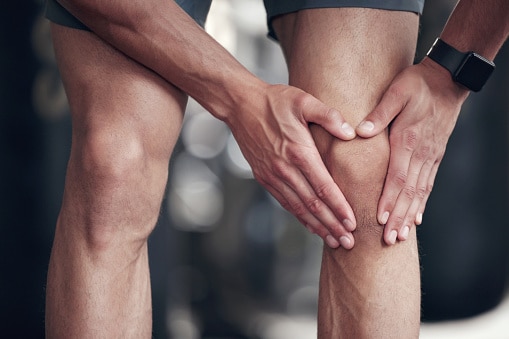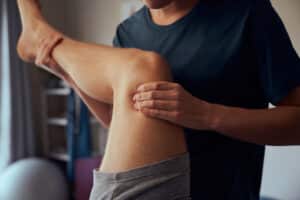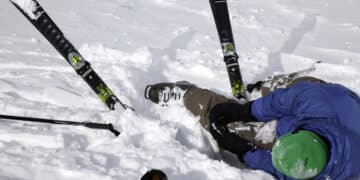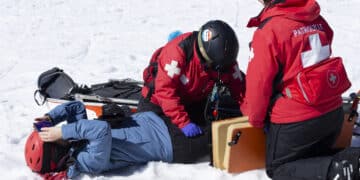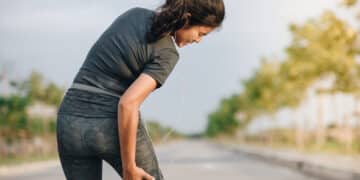Everything you need to know about knee pain: Causes and treatment options
Everything you need to know about knee pain: Causes and treatment options
Knee pain is a common problem that affects many people. There can be many reasons for this, from sporting injuries to age-related signs of wear and tear. At Waidfuss Physiotherapy, we attach great importance to providing our patients with comprehensive information about their complaints and possible treatment approaches. This text provides you with an overview of various causes and treatment options for knee pain, particularly for pain on the inside, outside and behind the kneecap. Topics such as knee osteoarthritis, patella tip syndrome, plica and cysts in the back of the knee are also covered.
Exercises for your knee
You can do this effective workout from the comfort of your own home.
Easy-to-implement exercises strengthen your knees and improve your balance. Start now and enjoy pain-free mobility!
Everything you need to know about knee pain: Causes and treatment options
Pain on the inside of the knee
Pain on the inside of the knee can have numerous causes. One common cause is inflammation of the pes anserinus tendon, which is caused by overloading or unfavorable movement patterns. Meniscus injuries, particularly to the medial meniscus, can also cause pain on the inside of the knee. Typical symptoms are swelling and restricted movement.
Treatment options:
- Physiotherapy: Individually adapted exercises to strengthen and stretch the muscles help to reduce the strain on the knee and promote healing. Regular exercise therapy aims to strengthen the muscles around the knee and improve mobility.
- Taping the knee: Special taping techniques can help to stabilize and relieve the knee. The tape supports joint function and reduces pain by structurally supporting the knee and preventing unwanted movements.
- Active therapy: Moderate activities such as cycling and light stability training can improve joint function and reduce pain. Balance exercises are also helpful to stabilize the muscles around the knee.
Pain on the outside of the knee
A frequently diagnosed cause of pain on the outside of the knee is the so-called iliotibial band syndrome (ITBS). This is when the iliotibial band is irritated by overuse, especially in runners and cyclists. This type of knee pain manifests itself as a burning or sharp pain on the outside of the knee.
Treatment approaches:
- Trigger point therapy IMTT®: Trigger point therapy can be used to treat painful muscle tension in a targeted manner. Special pressure techniques are used to release the muscle knots and relieve the pain.
- Stretching exercises: Regular stretching exercises for the iliotibial band are essential to reduce tension in the band and increase flexibility.
- Taping the knee: Machine or manual taping gives the knee stability and relieves the affected iliotibial band. This can promote healing and relieve pain.
- Active therapy: Light stability training and cycling are ideal for taking the strain off the IT band and strengthening the knee at the same time. Balance exercises are also useful for training and stabilizing the muscles around the knee.
Pain behind the kneecap
Pain behind the kneecap, also known as chondromalacia patellae or patellofemoral pain syndrome, is often caused by a misalignment of the kneecap. This can be caused by weak thigh muscles and misalignment of the legs. Knee pain during activities such as climbing stairs or after prolonged sitting is characteristic.
Therapy options:
- Physiotherapy: Targeted strengthening and stabilization exercises are essential. One focus here is on strengthening the thigh muscles to bring the kneecap into the correct position.
- Palpation: Precise diagnostic scans allow the muscles and joint structures to be better assessed and individual exercise programs to be developed.
- Active therapy: Cycling and light stability training strengthen the surrounding muscles and relieve pressure on the kneecap. Balance exercises are also helpful to improve the interaction of the muscle groups and increase stability.
Knee osteoarthritis
Knee osteoarthritis is a degenerative joint disease in which the cartilage in the knee gradually breaks down. This leads to pain, swelling and stiffness in the knee. Those affected often complain of difficulty getting going in the morning and pain after prolonged periods of exertion.
Treatment options:
- Physiotherapy: Exercise and strengthening programs at Waidfuss Physiotherapy support joint function and help to build up the muscles around the knee. Targeted exercises improve the mobility and stability of the knee joint.
- Lymphatic drainage: Manual lymphatic drainage helps to reduce swelling in the knee and supports the healing process by promoting lymph flow.
- Biomechanical advice: Improving everyday movements and correcting walking techniques can help to minimize the strain on the knee.
- Active therapy: Cycling and light stability training are ideal for promoting joint function and strengthening the muscles. Regular balance exercises also help to improve stability and relieve pressure on the joints.
Patella tip syndrome
Patella tip syndrome (jumpers knee) affects athletes in particular and causes pain on the underside of the kneecap. It is caused by chronic overloading of the patellar tendon and is often associated with a thickening of the tendon.
Treatment methods:
- Stretching and strengthening exercises: Special exercises to relieve the tendon and strengthen the surrounding muscles play a central role in the treatment of patella tip syndrome.
- Physiotherapeutic measures: Physiotherapy treatments include massages, cold and heat therapy as well as mobilizing exercises that are specially tailored to the needs of athletes.
- Taping the knee: The tape technique can be used to support the patellar tendon and stabilize the knee.
- Active therapy: Cycling and light stability training are important to relieve the strain on the tendon and strengthen the muscles. Balance exercises help to improve control over movements and avoid incorrect strain.
Plika syndrome
Plica syndrome is characterized by irritation or inflammation of a fold of mucous membrane in the knee joint. It can be caused by repeated microtrauma or incorrect loading. Typical symptoms are pain and a snapping sensation in the knee.
Treatment recommendations:
- Fitness programs: Targeted mobilization and strengthening programs in physiotherapy help to strengthen the muscles and relieve the inflamed mucosal fold.
- Manual therapy: Various manual techniques aim to improve the mobility of the knee joint and relieve pain points.
- Taping the knee: Professional taping can relieve the affected structures and minimize the snapping sensation in the knee.
- Active therapy: Cycling and light stability training help to strengthen the muscles and stabilize the knee. Balance exercises are also useful for improving the coordination and stability of the knee joint.
Cysts in the hollow of the knee
A Baker's cyst, also known as a popliteal cyst, is caused by an accumulation of fluid in the knee joint. It manifests itself as swelling and a feeling of pressure in the hollow of the knee.
Treatment options:
- Lymphatic drainage: The manuel lymphatic drainage helps to drain excess fluid and reduce swelling.
- Physiotherapy: Specialized exercises are used to improve the mobility of the knee joint. The aim is to reduce the pressure in the hollow of the knee and reduce the cyst.
- Active therapy: Cycling and light stability training help to strengthen the muscles and reduce the pressure on the cyst. Balance exercises also contribute to the stability of the knee joint.
Conclusion
Knee pain can have a variety of causes and requires targeted and individualized treatment without medication. At Waidfuss Physiotherapy, we offer a wide range of treatment options that are tailored precisely to your needs. Whether you suffer from knee osteoarthritis, patella tip syndrome or pain on the inside or outside of the knee - we are your experts for the targeted treatment of your knee pain. You can rely on our many years of experience and patient-oriented care.
For further information and to Making an appointment visit our website or contact us directly. We are happy to be there for you and support you on your way to a pain-free and active life.
Categories
- Osteoarthritis
- Leg
- Extensions
- Dry needling
- Elbow
- Foot
- Balance
- Hand
- Hip
- Pine
- Knee
- Headache
- Lymphatic drainage
- Mobilization
- Muscle pain
- Myofascial therapy
- Neck pain
- Physiotherapy Höngg
- Physiotherapy Wipkingen
- Physiotherapy Zurich
- Rehabilitation
- Back pain
- Shoulder arm
- Shoulder pain
- Pregnancy
- Dizziness
- Sports
- Trigger points
- Exercises
- Lower leg
- Injury prevention
- Wade
- What to do?
- Wound healing
After the cruciate ligament rupture: The way back to sport in Zurich
Your way back to sport after a cruciate ligament rupture A wrong step, an abrupt turn, a cracking sound...
MoreKnee injury after accident what to do?
After the accident: How physiotherapy helps with knee and leg injuries in Zurich Wipkingen The way back to full fitness is...
MoreHamstrings injuries
Hamstring injuries: Prevention, symptoms and rehabilitation of hamstring injuries The hamstrings - also...
MoreSprained foot
Holistic treatment of ankle sprains: Effectively counteracting sprains of the foot Ankle sprains,...
More
